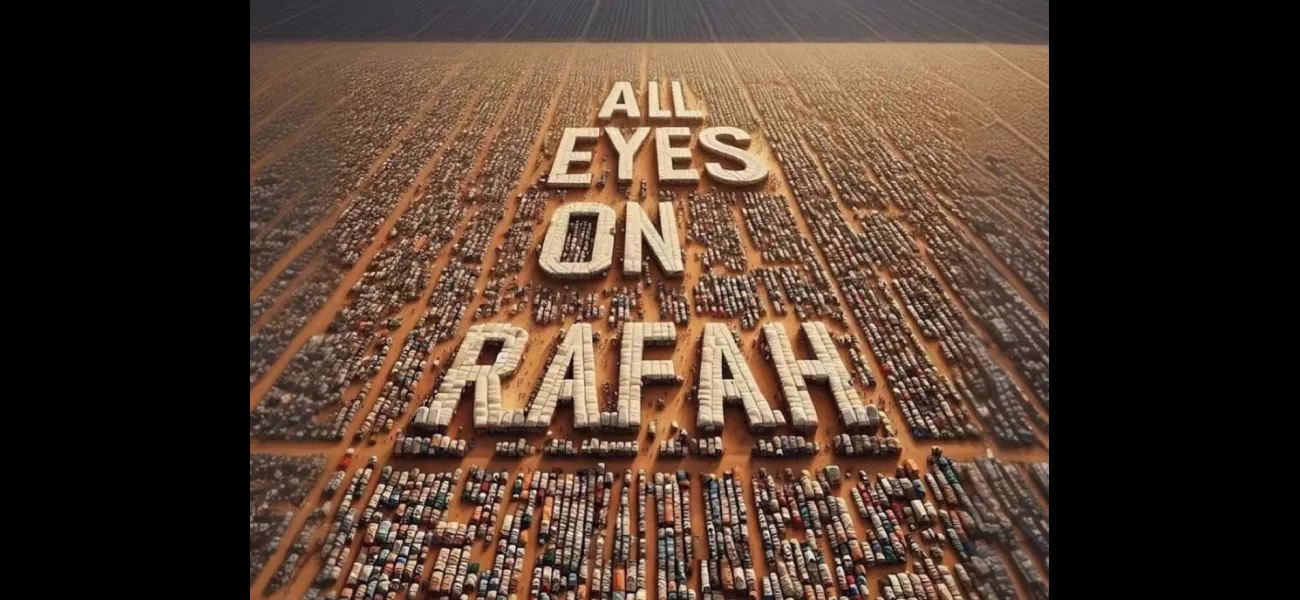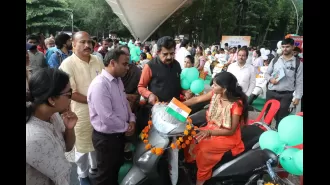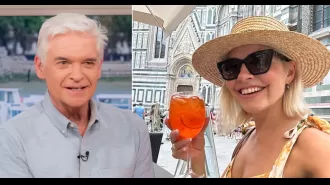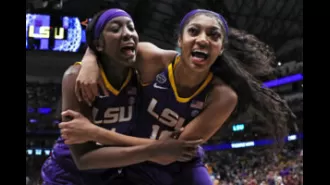A computer-generated image of Gaza went viral, sparking discussions about the capabilities of AI technology.
Unclear image: tents or truck beds on rust orange background with multi-coloured rectangles.
May 30th 2024.

In recent weeks, an image has been making its rounds on social media. At first glance, it's difficult to decipher exactly what it depicts. Some say it's a series of tents, while others believe it's truck beds against a rust orange background. A few have even suggested that it's a collection of multi-colored rectangles. What is clear is that in the background, there are mountains visible and in the foreground, there are words that read "All Eyes on Rafah." This reference to a city in Gaza has become the focal point of war coverage this week after an Israeli strike on a refugee camp killed dozens of Palestinians who had already been displaced.
Following the attack, the aforementioned image has seemed to be everywhere. Many suspect it was created using artificial intelligence and has been shared over 46 million times on Instagram alone. Some have questioned the effectiveness of simply posting an ambiguous graphic as a way to show support for the victims. Scientist Ayesha Khan pointed out that despite all the attention being on Rafah, the violence has not stopped. This has led to some critiques of the image's popularity and the passivity of those sharing it.
Despite the criticism, the image's momentum has continued. So where did the phrase "All Eyes on Rafah" come from and what does it signify? The phrase has been used in various graphics and images related to the ongoing war in Gaza for months, not just in relation to this specific viral image. It appears to have originated from comments made by Rik Peeperkorn, the leader of the World Health Organization's office in the West Bank and Gaza. In February, he stated that all eyes were on Rafah as it faced a wave of Israeli airstrikes while also housing over 1.5 million Palestinian refugees who had fled from other parts of Gaza.
The story template for the image on Instagram credits user shahv4012 as the creator, with a watermark to the account chaa.my listed as his second account. However, the user has not responded to requests for comment. The image's popularity can be attributed to its shareability and the way it is being shared on the platform. As it is not an actual image of the violence, there is less risk of it being suppressed by social media platforms. Additionally, the "add yours" feature on Instagram allows users to easily repost the image onto their own personal stories, contributing to its viral success.
Despite its popularity, there has been some criticism of the image. Some argue that it takes away from the reality of what is happening on the ground in Rafah. To truly understand the image, one would need to have some knowledge of the situation in Rafah and understand that it does not accurately depict the violence and destruction taking place. This has caused discomfort for some, as it directs attention away from the true horrors of conflict zones. As the image continues to circulate, it is important to remember the reality of the situation and not let the graphic distract from the ongoing violence in Gaza.
The image in question has been causing quite a stir lately. It's a bit hard to make out exactly what it depicts - is it a collection of tents? Perhaps it's truck beds against a backdrop of rust-colored orange? Some might even see a variety of multi-colored rectangles. Regardless of what it may look like, one thing is for sure - there are mountains visible in the background. In the foreground, we see the words "All Eyes on Rafah" - a phrase that has become synonymous with the recent coverage of the war in Gaza.
This phrase refers to the southernmost city in Gaza, which has been at the center of the conflict this week. It all started when an Israeli strike targeted a refugee camp in Rafah, a place that was supposed to be a safe zone for Palestinians. This attack resulted in the deaths of dozens of already displaced Palestinians. In the aftermath of this tragedy, the image in question has been widely shared across social media. It appears to have been generated using artificial intelligence and has been reposted over 46 million times on Instagram alone.
But with all this attention, some have raised questions about the impact of this image. Is it simply a passive act to share it? This was a point made by scientist Ayesha Khan on Instagram. She, along with others, have noted that posting an ambiguous image does not stop the violence from continuing. Despite these critiques, the image has continued to gain momentum. So where did the phrase "All Eyes on Rafah" come from? And why has this specific image gone viral?
The phrase itself has been circulating in various graphics and images related to the war in Gaza for months now. It was first used by Rik Peeperkorn, the leader of the World Health Organization's office in the West Bank and Gaza, back in February. At the time, over 1.5 million Palestinian refugees had sought shelter in Rafah, as they were fleeing from the violence in other parts of Gaza. Unfortunately, even Rafah was not safe, as it was also targeted by Israeli airstrikes in an attempt to "hit Hamas terrorists in the area," according to an IDF spokesperson. This is when Peeperkorn made the statement that all eyes were on Rafah, and it quickly became a commonly used phrase among activists and was incorporated into various graphics, including the one that has now gone viral.
So what makes this image so popular? According to Faiza Hirji, an associate professor at McMaster University who studies race, religion, and media, there are a few factors at play. For one, the image is highly shareable. Unlike actual images of war, which may be censored on social media platforms, this rendering is more "sanitized" and can be easily shared without fear of being suppressed. Additionally, the image's design, with its "add yours" feature on Instagram, makes it even more convenient for users to repost it on their own personal stories, contributing to its viral success.
However, there has also been some criticism of the image. Some argue that it takes away from the reality of the situation in Rafah, as it is not an accurate depiction of the violence and destruction happening on the ground. Others believe that it draws attention away from the actual events taking place. As Hirji explains, this can cause discomfort for some, as it directs everyone's focus to an image that doesn't truly capture the horrors of conflict zones.
In the end, the true impact of this image remains to be seen. But one thing is clear - it has sparked important conversations about the role of social media in raising awareness and the responsibility that comes with sharing images and information online. As the situation in Rafah continues to unfold, it is essential to remain informed and thoughtful about the content we consume and share.
Following the attack, the aforementioned image has seemed to be everywhere. Many suspect it was created using artificial intelligence and has been shared over 46 million times on Instagram alone. Some have questioned the effectiveness of simply posting an ambiguous graphic as a way to show support for the victims. Scientist Ayesha Khan pointed out that despite all the attention being on Rafah, the violence has not stopped. This has led to some critiques of the image's popularity and the passivity of those sharing it.
Despite the criticism, the image's momentum has continued. So where did the phrase "All Eyes on Rafah" come from and what does it signify? The phrase has been used in various graphics and images related to the ongoing war in Gaza for months, not just in relation to this specific viral image. It appears to have originated from comments made by Rik Peeperkorn, the leader of the World Health Organization's office in the West Bank and Gaza. In February, he stated that all eyes were on Rafah as it faced a wave of Israeli airstrikes while also housing over 1.5 million Palestinian refugees who had fled from other parts of Gaza.
The story template for the image on Instagram credits user shahv4012 as the creator, with a watermark to the account chaa.my listed as his second account. However, the user has not responded to requests for comment. The image's popularity can be attributed to its shareability and the way it is being shared on the platform. As it is not an actual image of the violence, there is less risk of it being suppressed by social media platforms. Additionally, the "add yours" feature on Instagram allows users to easily repost the image onto their own personal stories, contributing to its viral success.
Despite its popularity, there has been some criticism of the image. Some argue that it takes away from the reality of what is happening on the ground in Rafah. To truly understand the image, one would need to have some knowledge of the situation in Rafah and understand that it does not accurately depict the violence and destruction taking place. This has caused discomfort for some, as it directs attention away from the true horrors of conflict zones. As the image continues to circulate, it is important to remember the reality of the situation and not let the graphic distract from the ongoing violence in Gaza.
The image in question has been causing quite a stir lately. It's a bit hard to make out exactly what it depicts - is it a collection of tents? Perhaps it's truck beds against a backdrop of rust-colored orange? Some might even see a variety of multi-colored rectangles. Regardless of what it may look like, one thing is for sure - there are mountains visible in the background. In the foreground, we see the words "All Eyes on Rafah" - a phrase that has become synonymous with the recent coverage of the war in Gaza.
This phrase refers to the southernmost city in Gaza, which has been at the center of the conflict this week. It all started when an Israeli strike targeted a refugee camp in Rafah, a place that was supposed to be a safe zone for Palestinians. This attack resulted in the deaths of dozens of already displaced Palestinians. In the aftermath of this tragedy, the image in question has been widely shared across social media. It appears to have been generated using artificial intelligence and has been reposted over 46 million times on Instagram alone.
But with all this attention, some have raised questions about the impact of this image. Is it simply a passive act to share it? This was a point made by scientist Ayesha Khan on Instagram. She, along with others, have noted that posting an ambiguous image does not stop the violence from continuing. Despite these critiques, the image has continued to gain momentum. So where did the phrase "All Eyes on Rafah" come from? And why has this specific image gone viral?
The phrase itself has been circulating in various graphics and images related to the war in Gaza for months now. It was first used by Rik Peeperkorn, the leader of the World Health Organization's office in the West Bank and Gaza, back in February. At the time, over 1.5 million Palestinian refugees had sought shelter in Rafah, as they were fleeing from the violence in other parts of Gaza. Unfortunately, even Rafah was not safe, as it was also targeted by Israeli airstrikes in an attempt to "hit Hamas terrorists in the area," according to an IDF spokesperson. This is when Peeperkorn made the statement that all eyes were on Rafah, and it quickly became a commonly used phrase among activists and was incorporated into various graphics, including the one that has now gone viral.
So what makes this image so popular? According to Faiza Hirji, an associate professor at McMaster University who studies race, religion, and media, there are a few factors at play. For one, the image is highly shareable. Unlike actual images of war, which may be censored on social media platforms, this rendering is more "sanitized" and can be easily shared without fear of being suppressed. Additionally, the image's design, with its "add yours" feature on Instagram, makes it even more convenient for users to repost it on their own personal stories, contributing to its viral success.
However, there has also been some criticism of the image. Some argue that it takes away from the reality of the situation in Rafah, as it is not an accurate depiction of the violence and destruction happening on the ground. Others believe that it draws attention away from the actual events taking place. As Hirji explains, this can cause discomfort for some, as it directs everyone's focus to an image that doesn't truly capture the horrors of conflict zones.
In the end, the true impact of this image remains to be seen. But one thing is clear - it has sparked important conversations about the role of social media in raising awareness and the responsibility that comes with sharing images and information online. As the situation in Rafah continues to unfold, it is essential to remain informed and thoughtful about the content we consume and share.
[This article has been trending online recently and has been generated with AI. Your feed is customized.]
[Generative AI is experimental.]
0
0
Submit Comment





